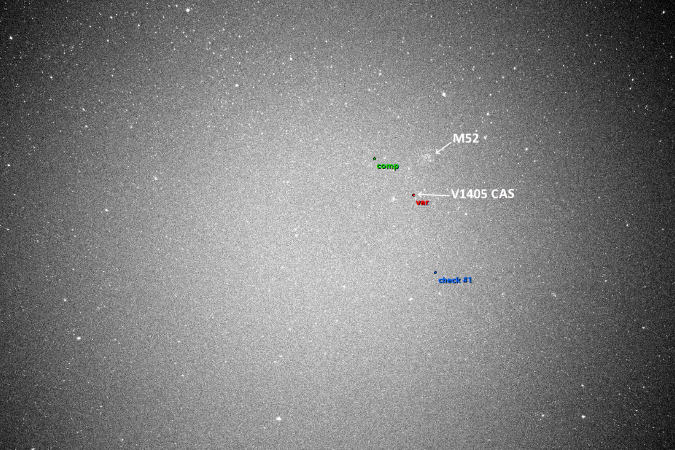May 17, 2021, Dr. Gerold Holtkamp and Dr. Thomas Kunzemann
(Light curve updated on May 6, 2022)
The observation of the Nova V1405 CAS is described. Brightness measurements were carried out over a longer period of time, from April 1st, 2021 to May 15th, 2022. Together with measurements from other international authors, an atypical behavior for a nova was demonstrated.
Some will say that it's nice to follow a star that was once very faint, then became bright and then slowly faded again, a nova, but compared to other astropictures it's not particularly spectacular... .
The observations described here are actually less about colors and structures and more about information that can be obtained from the course of the light curve. Given the very large distances of most stars, direct lateral resolution images are not possible. You therefore have to get the information out of the light that comes to us. While the brightness is still relatively easy for us amateur astronomers to determine, it is challenging to obtain a sequence of measurements that is as continuous as possible - even more so because of the moody weather here and the disruptions caused by the corona pandemic. The spectral decomposition of the light would provide additional information. However, the requirements for this go beyond our (current) equipment.
The Nova V1405 CAS consists of two stars - a white dwarf and a main sequence star - that orbit each other closely. The distance between the two components is so small that matter passes from the main sequence star to the white dwarf. This matter accumulates in an accretion disk around the white dwarf. Due to the constant increase in mass, this heats up more and more until such a high temperature is reached that an explosive thermonuclear reaction begins.

Source: Stellarium

The discovery of the nova by Yuji Nakamura, Kameyama, Mie, Japan, is dated March 18, 2021. On this date it was reported to the CBAT (Central Bureau for Astronomical Telegrams) of the IAU (International Astronomical Union) (3). The official name is V1405 CAS. The position is said to coincide with the eclipsing star CzeV3217 = Gaia EDR3 2015451512907540480 (∼1.3”). The star system has an orbital period of 0.376938 days and is 5500 light-years away from us. The brightness before the eruption was about 15 mag.
On the day of discovery, the nova had a magnitude of 9.371 in the B band. On March 27th It then became significantly brighter at 7.9 mag. We knew it would be a challenge, not so much in terms of the recording technique, but more in terms of the weather. This is known to be capricious and in our part of the world the weather report often says “overcast skies”. In addition, the nights became shorter and shorter in April, May and June. For once, the moon was not a problem given the relatively high brightness of the nova and the position in the constellation Cassiopeia. For a long time there was a nighttime curfew due to the corona pandemic, so only your own garden remained as a place to observe, which was definitely not a disadvantage. A garden/balcony was quickly accessible even when there were short-term breaks in the clouds.

The first measurement was made on April 1st at 11 p.m. CEST (21 UTC). Gerold Holtkamp used the following setup for this: camera Canon 500DA, filter IDAS LPS-D2, 218mm, F/5.6, ISO1600. He then carried out the following measurements exclusively with the following setup: Camera Canon 6D, IDAS LPS-D2, 300mm, F/5.6, ISO3200. Tracking was carried out using a Star Adventurer travel mount. The recording location was my garden, mostly Osnabrück.
Thomas Kunzemann also used a Canon 6D as a camera, but with a 480mm focal length and ISO 3200. His location was his balcony in Preußisch-Oldendorf.
Photometry was carried out using the MuniWin software. Only the green channel was evaluated. As a rule, the average value was formed from 20 images and compared with the star HD 221143 to obtain an absolute value. For the comparison star, the Simbad astronomical database gives a brightness in the V channel of 8.48 mag.


V1405 CAS initially seemed to go through the classic brightness decline (measurements on April 1st and 3rd). Then there was a slow increase in brightness (measurements 12.4 to 5.5), which was followed by a rapid increase of almost 2 mag and an equally rapid decrease (measurements 7.5 to 16.5). This is definitely not the classic course of a nova. What led to this atypical behavior will certainly be discussed in astronomical circles in the near future. Further developments remain to be seen.
(1) https://de.wikipedia.org/wiki/Nova_(Stern)
(2) https://www.spektrum.de/lexikon/astronomie/nova/314
(3) http://tamkin1.eps.harvard.edu/unconf/followups/J23244760+6111140.html
(4) https://www.aavso.org/LCGv2/